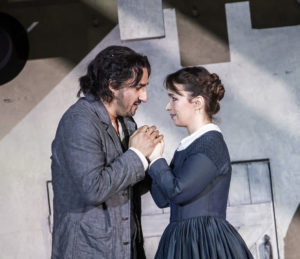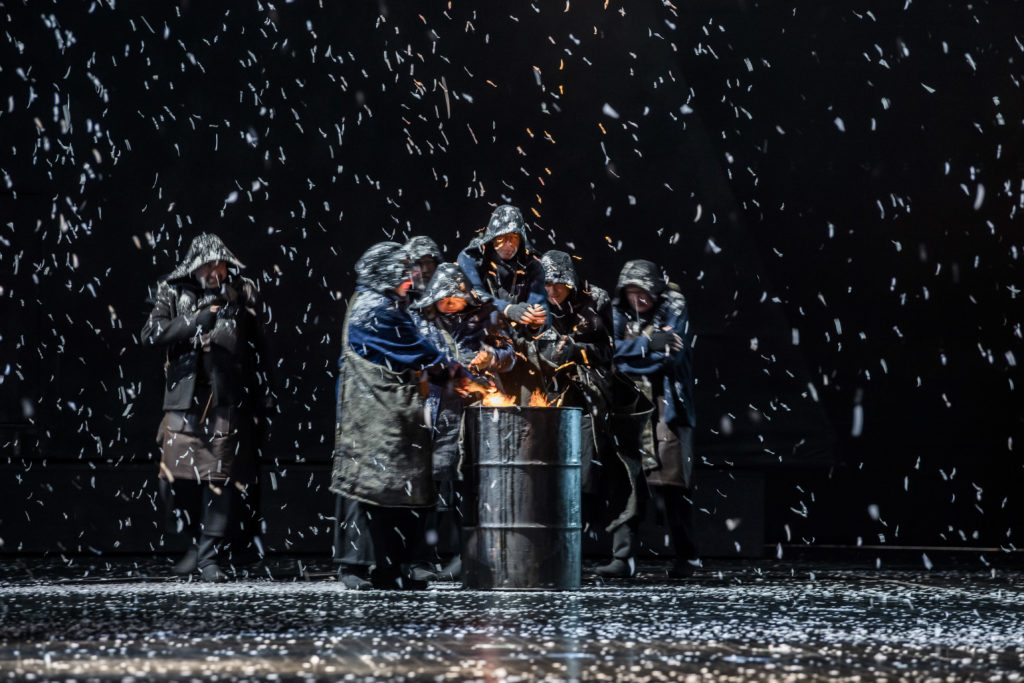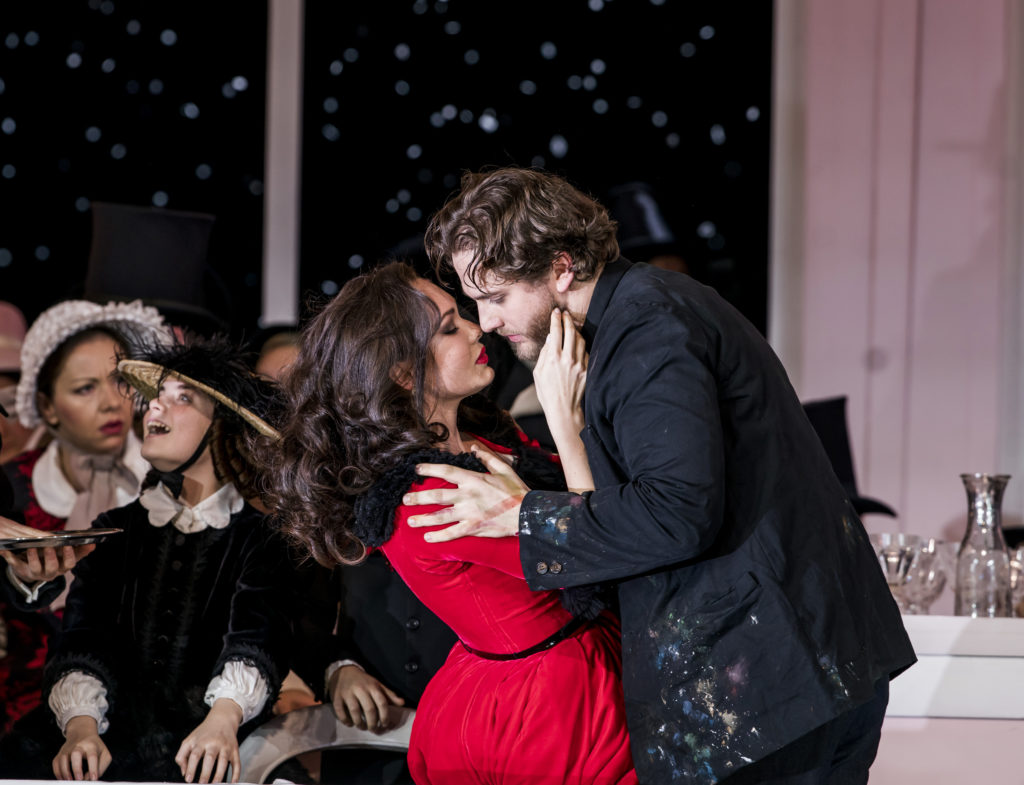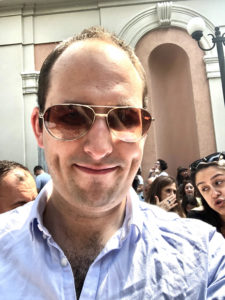
Royal Opera House 2019-20 Review: La Bohème
Charles Castronovo, Aida Garifullina, Simona Mihai Merge With Jone’s Reflexive Production
By Benjamin Poore(Credit: Royal Opera House /Tristram Kenton)
This review is for the performance on Jan. 10, 2020.
Alongside with Richard Eyre’s classic production of “La Traviata,” Richard Jones’ “La bohème” is an important weapon in the Royal Opera’s commercial arsenal, and will therefore be making 16 appearances this year, with myriad casts and three conductors.
This is its second revival since Jones’ production hit the stage in autumn 2017, replacing John Copley’s beloved 40-year old staging, resplendent with period detail and resolutely naturalist. Jones brings a considerable break with the past in his approach, pointing the way towards thought-provoking possibilities for the work, though it is a clearly a show that defers to the need for regular revival and breadth of appeal.
Frostier Reflexivity
The central idea of the staging is promising enough and operates consistently across different levels of the production, even if it feels a bit deflected by the aforementioned priorities. Jettisoning Copley’s realism for a starker and emotionally frostier reflexivity, Jones is keen to remind us of the artificiality and staginess of the work itself. Uncostumed stagehands visibly move the box-like sets around, which pile up at the back of the stage as the show goes on, and harshly backlighting of the act one attic disdains naturalistic illusion, along with a calculated paucity of props.
The rock opera lighting that glares into the audience from the back of the stage occasionally might be a bit much in getting across the message that it is an opera about artists and itself an artifice, but it’s a smart enough conceit that works with the text rather than against it.
The rakish Schaunard, himself a performer, can’t help but utter “La commedia è stupenda!” in Act two as Marcello and Musetta play out their melodrama; in Jones’ hands the scene echoes Colline mocking Rodolfo’s “vain, fragile drama,” torched to warm them up in Act one. And the boys’ deliberately stagey horseplay in Act four, bursting with fun, underlines the fact that in the picaresque source text, Henri Murger’s “Scènes de la vie de bohème,” the four of them aren’t even really poor students but bourgeois fakes. For them all the world really is a stage.
This idea extends to the characterization, and is all the more fun for it, warming up what can at times feel like a rather distant production. When Marcello paints his Red Sea at the top of the opera, his brushes work on the invisible fourth wall that separates audience from stage; so too in the second act do the chorus solicit the public directly when hawking their wares, presumably reminding patrons in the stalls of the eye-watering amounts of money they’ve exchanged for a taste of la vie boheme. Colline’s coat is a red military number straight from the costume box – or even Sgt. Pepper’s – rather than the kind of thing you’d wear to the library.

(Credit: Royal Opera House /Tristram Kenton)
Complex & Fastidious Characterizations
Simona Mihai gamely stepped in for an indisposed Sonya Yoncheva. She is herself a veteran of the production, having sung it last year in the first revival, and seemed to fit neatly back into the movement and characterization, quite commendable given extreme the short notice; she is slated to sing Musetta later in this run of performances. Hers is a humane and fastidious characterization whose subtler dramatic waves make for a powerful contrast with Musetta’s deliberate overripeness.
Vocally the picture was more mixed. Mihai could sound a touch acidic and squally above the stave, and struggled to find much dynamic flexibility below mezzo forte. Her legato tended towards choppiness and wanted for some lubrication in “Mi chiamano Mimì.”
Her best singing undoubtedly came in acts three and four, particularly her springtime duet with Charles Castronovo’s Rodolfo, spotlighting the moments of translucency and fragility so vital to the character.
Castronovo undoubtedly had the best night, even if the steel undergirding the velvet in his voice became a rather blunt instrument at points. He was certainly dashing enough in the first scene and ardent throughout, and the voice remained accordingly fresh and lively.
That it is not the most rounded or adventurous portrayal of the character is not helped by the production, which seemed to shy away from examining the more ambivalent or troubled aspects of the character, namely his jealousy, quick temper, and inability to face Mimí’s illness.

(Credit: Royal Opera House /Tristram Kenton)
Castronovo found a strong sparring partner in Andrez Filończyk’s Marcello, who navigated the role’s treacherous upper reaches with bags of glittering squillo, and his banter in act one was convincingly laddish. He did well in Act two to respond to Musetta’s excesses without taking the whole thing over the top – he has to be silly enough to match her without taking the show into total self-parody – and their chemistry in the Act three bust-up was superb.
Speaking of Musetta, the production casts her as s an opera singer in an opera, so no dramatic extravagance was too much. Aida Garifullina, in her house debut, made Musetta’s tantrums and knicker-throwing deliciously salty, and she clearly relished chewing the scenery in a performance that cared not a whit for tasteful or artful discretion.
But casting a coloratura such as Garifullina as Musetta trades off a more traditional, heavy seductiveness possessed by the character for something bubblier, more capricious and mischievous. It ultimately works well with the show’s emphasis on her brand of silly playfulness and the flimsy artificiality of the whole premise.
Peter Kellner’s Colline was a particularly lively sketch of the character, vocally and dramatically, stuffing his face in act two with earthy gusto as the chaos unfolds around him. One wonders if there is an impression of Karl Marx in Jones’ picture of him: the philosopher was famously unkempt, frequently pawning his possessions, and had a renowned fondness for his victuals.
There are some smart touches in Stewart Laing’s designs, alongside what is a relatively traditional spectacle – Act two’s sets make a dynamic contrast to the rather chilly spareness of the attic or the bleak entrance to the city in act three – along with acres of snow.
The rectangular boxes of the Act two arcades and Café Momus positively teem with life – “Quanta folla! Che chiasso!,” as the text says – and burst with energy, all founded on a carefully directed melange of chorus and actors. But at the ends of the raked arcades and behind the café windows looms an abyssal darkness, as if to recall that this is only so much empty pleasure.
Emmanuel Villaume conducted with crisp – even breathless – intensity and focus. Rarely have the opening bars, with that fiendishly slippery semiquaver rest on the downbeat, sounded so well-coordinated in the lower reaches. Sometimes excitement got the better of the band and there were some problems with balance in the first act, with singers getting lost in a sound that was robust and effulgent.
A brisk performance carried the audience out of the auditorium before ten o’clock, but it wanted for delicacy and transparency, and greater opportunities to linger on Puccini’s exquisitely sculpted details and poised timbral combinations in the orchestra.
It’s hard to call this an instant classic of a night, but there were undeniably some elements that emphasized why this “Bohème” is such a crucial staple of the Royal Opera House’s repertory.



